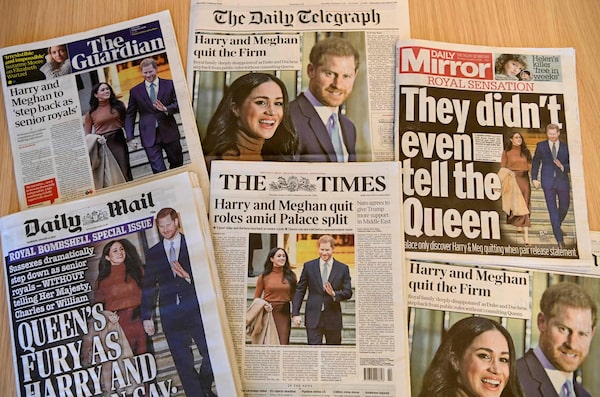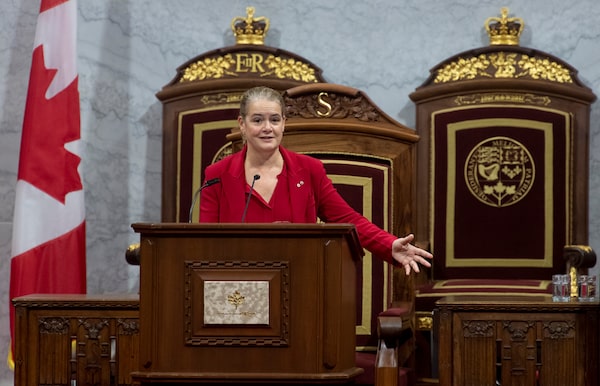Prince Harry and Meghan, Duchess of Sussex, have given up their official roles in the Royal Family after a tumultuous week of back-and-forth with the Queen. It included a controversial plan to split their time between Britain and North America, and while the Sussexes have yet to say where they plan to live, Canada seems like their likely destination. For Canadians, that’s raised unprecedented questions about how to live alongside royalty on Canadian soil, and who will pay for their security and lifestyle. Here’s a primer on the story so far.
Why ‘Megxit’?
Windsor, Britain, 2018: Prince Harry gestures next to his wife Meghan as they ride a horse-drawn carriage after their wedding ceremony at St George’s Chapel in Windsor Castle.Damir Sagolj/Reuters/Reuters
After their whirlwind courtship and 2018 wedding, Prince Harry and Meghan, Duchess of Sussex, became important faces for the Royal Family, part of the so-called Fab Four with Prince William and Catherine, Duchess of Cambridge.
But a year of relentless and critical British media coverage took its toll on the Sussexes. Britain’s Mail on Sunday newspaper published a private letter between the Duchess and her father, Thomas Markle, prompting her to sue. Tabloid headlines panned the Duchess for everything from eating avocados while pregnant to not accepting the Queen’s invitations to stay in Scotland. Harry fought back, saying the press were hounding her the way they had his mother, Diana, Princess of Wales. Critics also pointed to double standards in how the Duchess of Sussex, who is a mixed-race American, was treated far more harshly after joining the family than the Duchess of Cambridge, who is white.

British newspaper front pages from Jan. 9 advertise the news of the Sussexes' plan to 'step back' from royal duties.DANIEL LEAL-OLIVAS/DANIEL LEAL-OLIVAS/AFP via Getty Images
Behind the scenes, the Sussexes pressed the Queen for months to get more financial independence and duties that would expose them less to criticism from the British establishment. On Jan. 8, they forced the Queen’s hand by announcing that they would step back from senior royal duties and would no longer participate in the “rota” publicity system for journalists dedicated to royal coverage. At a Jan. 13 emergency meeting at her Sandringham estate, the Queen agreed to a “period of transition” in which the Sussexes would split their time living in Canada and Britain until new roles were found for them.
Five days later, an even more substantial withdrawal plan was announced: The Sussexes would no longer represent the Queen in formal capacities, would stop using their HRH (“His/Her Royal Highness”) titles, would stop receiving public funds and would repay £2.4-million ($4-million) in British public money already spent refurbishing their home near Windsor Castle. The Queen’s announcement gave no details about where they planned to live, adding that “Buckingham Palace does not comment on the details of security arrangements,” including who would pay for their security in private life.
Why Canada?

Toronto, 2017: Prince Harry and his then-girlfriend Meghan Markle attend a wheelchair tennis event at the Invictus Games, a sporting event for wounded soldiers founded by the prince.Nathan Denette/Nathan Denette/The Canadian Press via AP
Canada has figured prominently in the Sussexes’ relationship since it began. It was in Toronto that they made their public debut as a couple in 2017, when she was still Meghan Markle and star of the TV series Suits, which was filmed in Toronto, and he was patron of the Invictus Games, which were taking place there. After their marriage and the birth of son Archie, the Sussexes spent part of their Christmas holidays in a Vancouver Island mansion, where the Duchess says Archie was impressed with Canada’s natural beauty.
How will this work? Key unanswered questions

In North Saanich, Vancouver Island, tall trees obscure the view of the property where the Sussexes are believed to be staying.MARK GOODNOW/AFP via Getty Images/AFP/Getty Images
Where will they live? For now, the Sussexes appear to be staying in the same North Saanich property where they spent their Christmas break. Given the Sussexes’ praise of Vancouver Island after their vacation there, some royal experts suspect their destination is Victoria, the province’s historically anglophilic capital. The Duchess also made a Jan. 14 appearance at a Vancouver women’s shelter. Either B.C. city would bring the Duchess within easier travel distance from her mother, Doria Ragland, who lives in Los Angeles.
What will their citizenship status be? British monarchs are not citizens of the countries where they reign, since citizenship means being a subject of the sovereign, and sovereigns cannot be subjects to themselves. Royal Family members in line to the throne, though, are British subjects, so from an immigration standpoint that means the Sussexes are no different than any other prospective newcomers. Ordinarily, they would have to apply for permanent residency under a points system weighing their skills and education. The federal immigration minister can give them permanent residency if he wants, but that power has rarely ever been used.
Who’s paying for their security? “There are discussions going on” about whether and how much Canada’s government should pay for the Sussexes’ security in Canada, Prime Minister Justin Trudeau says. One security consultant told The Globe and Mail the security detail could cost more than $10-million annually, including personal bodyguards, vehicles, and fences and surveillance around their residence, wherever that will eventually be.

Prince Harry with his father, Prince Charles, in 2018.Matt Dunham/The Associated Press/The Associated Press
Where does their money come from? The Royal Family’s official expenses are normally paid for through the Sovereign Grant, a fund drawn from the profit of real estate that the monarch technically owns, but whose revenue is administered by the British treasury. The Sussexes have published a detailed funding model in which they say they only got 5 per cent of their money from the Sovereign Grant last year, and they want to take that down to zero. The other 95 per cent of their income is from Harry’s father, Prince Charles, who owns a private estate called the Duchy of Cornwall and uses its profit for his own expenses and charitable ventures.
Will they go into business together? Stepping away from senior royal duties gives the Sussexes more leeway to start their own businesses, which members of the Royal Family are prohibited from doing. They took steps in this direction months before the royal split: According to British patent-office records, they applied last summer for “Sussex Royal” trademarks, potentially setting up another dispute with the Royal Family over the word “royal,” a highly protected term in British intellectual-property law. The range of products and services suggested in the application suggests they plan a style of philanthropy work more like a private-sector foundation than the traditional practices of the Royal Family.
Canada’s monarchy in context

Governor-General Julie Payette speaks to the 25th Conference of Speakers and Presiding Officers of the Commonwealth during a ceremony in the Senate chamber.Adrian Wyld/The Canadian Press/The Canadian Press
Princes have come to live in Canada before – Queen Victoria’s son Prince Arthur, Duke of Connaught, was governor-general in the 1910s – but there is no precedent for former royalty coming to stay.
The Sussexes’ renunciation of their HRH status has spared Canada from the potentially messy constitutional and protocol questions of having a British prince sharing the schedule of public events with Canadian-appointed governors-general and lieutenants-governor. As far as Canada and Britain’s governments are concerned, their monarchies are separate offices that happen to be held by the same person and are handed down within the same family, and for the past century, the conventions of the Canadian Crown have evolved to reinforce that independence. For instance, Canada rejected the British-style system of aristocratic titles, so royalty that visit Canada have no constitutional role as Canadian princes or princesses. Their titles and roles are British, even though they may be visiting on behalf of a Canadian sovereign and could thus be described as a Canadian Royal Family.
So in ceasing to be HRHs, the Sussexes, if they do come to Canada after all, would effectively be doing so as private citizens – but with all the notoriety and public attention that being former royalty entails. Meanwhile, their exit plan has escalated questions among monarchists and republicans alike about whether other young royalty could withdraw from royal duties, and if so, what the future Royal Family could look like. The Queen’s heir-apparent, Prince Charles, has said he envisions a leaner Royal Family centred on the monarch and their heirs, in which the “spares” – family members like Prince Harry on other branches of the line of succession – play less of a role.
Opinion and analysis
Editorial: Harry and Meghan, and why members of the Royal Family can’t live in Canada
Philippe Lagassé: The Canadian Crown meets residual royalty
Robyn Urback: Meghan and Harry’s very millennial struggle, give or take about $40-million
Anne T. Donahue: Meghan and Harry coming to Canada is the fairy-tale ending we all deserve
Carolyn Harris: Long may it reign: Forget about Harry and Meghan, the monarchy always comes first
Compiled by Globe staff
With reports from Paul Waldie, Janice Dickson, The Canadian Press and The Associated Press